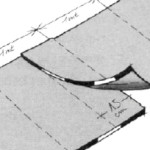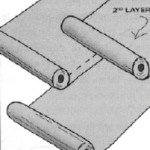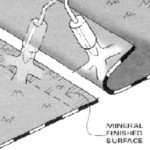1. Arrangements of the Sheets
The sheets should be laid overlapping each other starting from water outlets or roof valleys.

2. Side-to-side and head-to-tail overlaps
Side – to – side:
These create the joint lengthwise between two sheets. The sheets should be carefully bonded until a bead of compound about 10 mm is squeezed out of the join along the overlap line.
Side – to – side overlaps (side lap) should not be less than 100 mm wide.
Head – to – tail:
These create the joints along the shorter sides of the sheets. They too must be treated with care. The membrane should be heated enough for a bead of compound about 10 mm wide to be squeezed out. The overlapped section (end lap) should not be less than 150 mm wide.
When reinforced sheets are laid semi-bonded with “non – woven” polyester near to the head – to – tail overlaps, the sheet should be bonded completely to the laying surface to at least 1 m.


3. Fully Bonded Application
Both the membrane and the substrate should be heated with emphasis on the roll. The membrane sheet already laid should also receive a direct flame.

4. 45º Cut on the head – to – tail overlap
5. Double Layer Covering
6. Head – to – tail overlaps of mineral finished membranes
The bonded areas on side – to – side are free from Mineral but for the head – to – tail Mineral Finish overlaps the underlying membrane needs to be heated to draw the compound to the surface. This is done by persistent heating and will give perfect bonding of the two edges when the compound on the upper sheets has also been heated.
Important Note
This data sheet is issued as a guide to the use of the product(s) concerned. Whilst a.b.e.® endeavours to ensure that any advice, recommendation, specification or information is accurate and correct, the company cannot – because a.b.e.® has no direct or continuous control over where and how abe products are applied – accept any liability either directly or indirectly arising from the use of a.b.e.® products, whether or not in accordance with any advice, specification, recommendation, or information given by the company.




